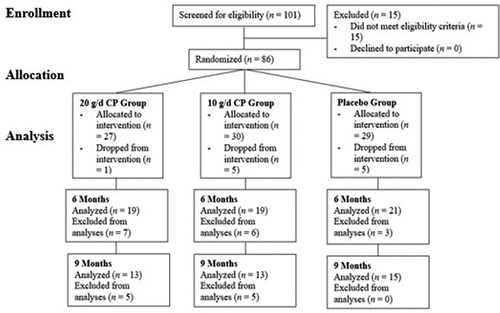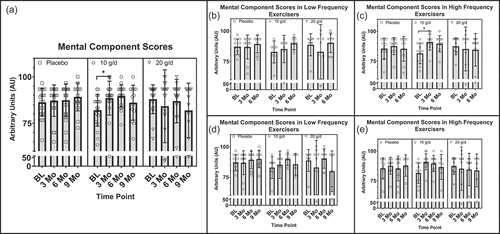Figures & data
Figure 1. Flowchart of participant recruitment, dropouts, and randomization before and during study intervention. CP = collagen peptides, g = grams, d = day.

Table 1. Baseline characteristics for participants who completed the 6-month and 9-month arm of the study intervention.
Table 2. Average macronutrient and energy intake from baseline to 6 months.
Figure 2. (a) Differences between treatment groups in KOOS ADLs at baseline, 3 months, and 6 months, with reported p-value for group by time interaction. (b) Differences between low frequency exercisers in treatment groups in KOOS Pain at baseline, 3 months, and 6 months. (c) Differences between high frequency exercisers in treatment groups in KOOS Pain at baseline, 3 months, and 6 months. AU = arbitrary units, g = grams, d = day, ADLs = activities of daily living, KOOS = Knee injury and Osteoarthritis Outcome Score, LF = low frequency, HF = high frequency.

Table 3. Average survey measure scores for the KOOS subdomains.
Figure 3. a) Differences between treatment groups in the VR-12 MCS at baseline, 3 months, 6 months, and 9 months, with reported p-value for group by time interaction. (b) Differences between low frequency exercisers in treatment groups in MCS at baseline, 3 months, and 6 months. (c) Differences between high frequency exercisers in treatment groups in MCS at baseline, 3 months, and 6 months, with p-value for group by time interaction. (d) Differences between low frequency exercisers in treatment groups in MCS at baseline, 3 months, 6 months, and 9 months. (e) Differences between high frequency exercisers in treatment groups in MCS at baseline, 3 months, 6 months, and 9 months, with p-value for group by time interaction. AU = arbitrary units, g = grams, d = day, MCS = mental component score, LF = low frequency, HF = high frequency.

Figure 4. (a) Differences between treatment groups in the VR-12 PCS at baseline, 3 months, 6 months, and 9 months, with reported p-value for group by time interaction. (b) Differences between males in treatment groups in the VR-12 PCS at baseline, 3 months, 6 months, and 9 months. (c) Differences between females in treatment groups in the VR-12 PCS at baseline, 3 months, 6 months, and 9 months. AU = arbitrary units, g = grams, d = day, PCS = physical component score.

Table 4. Average VR-12 mental and physical component scores.
